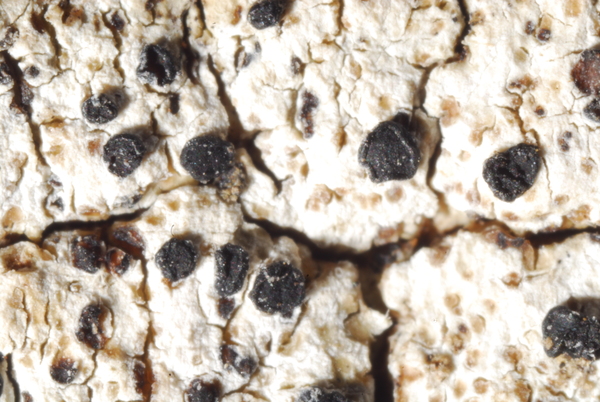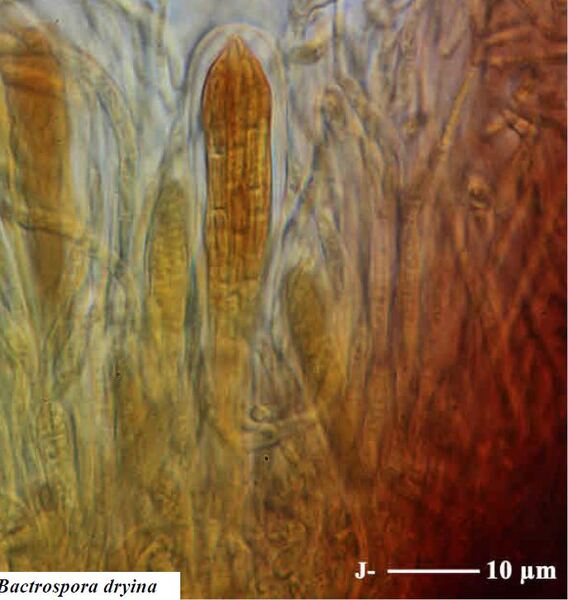Bactrospora dryina (Ach.) A. Massal.
Ric. Auton. Lich. Crost.: 133, 1852. Basionym: Lichen dryinus Ach. - Lichenogr. Suec. Prodr.: 16, 1799.
Synonyms: Arthonia dryina (Ach.) Jatta; Lecanactis dryina (Ach.) Vain.; Lecanactis dryophila Lettau; Lecidea dryina (Ach.) Ach.; Lecidea dryina var. lilacina Ach.
Distribution: N - Ven, Piem, Lig (Giordani & Brunialti 2000). C - Tosc (Brunialti & Frati 2010, Brunialti & al. 2012b, Frati & Brunialti 2023), Laz (Stofer 2006), Sar (Stofer 2006). S - Pugl (Nimis & Tretiach 1999), Cal (Puntillo 1996), Si (CLU 12717).
Description: Thallus crustose, continuous to slightly cracked, thin, mostly episubstratic, white to grey-white. Apothecia lecideine, black, adnate to sessile, round to often irregular in outline (often oval or sublobulate) 0.2-0.7 mm across, with a black, at first flat then convex, uneven, epruinose disc and a thin, finally excluded proper margin. Proper exciple laterally well-developed, dark red-brown, usually closed below the hymenium, I+ reddish, K/I+ deep blue, K+ blackish olive; epithecium dark brown, composed of irregularly shaped, agglutinate, strongly branched and anastomosing paraphysoid tips; hymenium colourless, 75-110 µm high, I+ pale red or blue in the inner part, K/I+ pale blue; paraphysoids richly anastomosing, not thickened at apex, richly branched at apex to form a reticulate epithecium; subhymenium pale to dark brown, up to c. 150 µm high; hypothecium dark red-brown. Asci 8-spored, narrowly clavate to cylindrical, with a distinct stipe and foot-like base, easily separated from the ascogenous hyphae and often broken, bitunicate-fissitunicate, with a narrow, K/I+ pale blue apex, with an apical dome penetrated by a small ocular chamber surrounded at the base by a small K/I+ dark blue ring-like zone, the exoascus thin and refringent, the endoascus slightly hemiamyloid, 70-100 x 11-13 µm. Ascospores transversely multi-septate, hyaline, at first filiform and 70-77 x (1-)2-3 µm, but later fragmenting into individual, rectangular to cuboid part-spores which measure (2-)3-8 x 2-3 µm. Pycnidia immersed or semi-immersed, punctiform, globose or subglobose, the wall brown at apex, colourless to pale brown basally. Conidia straight, 3-5 x 1-1.5 µm. Photobiont trentepohlioid. Spot tests: K-, C-, KC-, P-. Chemistry: without lichen substances. Note: a mild-temperate to Mediterranean-Atlantic species found on bark of old, isolated deciduous trees, especially oaks, on faces which are seldom wetted by rain; mainly Tyrrhenian, perhaps extinct in the plains of the North, and certainly declining. It is included in the Italian red list of epiphytic lichens as “Vulnerable” (Nascimbene & al. 2013c).
Growth form: Crustose
Substrata: bark
Photobiont: Trentepohlia
Reproductive strategy: mainly sexual
Most common in areas with a humid-warm climate (e.g. most of Tyrrenian Italy)
In underhangs rarely wetted by rain
Commonnes-rarity: (info)
Alpine belt: absent
Subalpine belt: absent
Oromediterranean belt: absent
Montane belt: absent
Submediterranean belt: extremely rare
Padanian area: absent
Humid submediterranean belt: extremely rare
Humid mediterranean belt: extremely rare
Dry mediterranean belt: absent

Predictive model
Herbarium samples
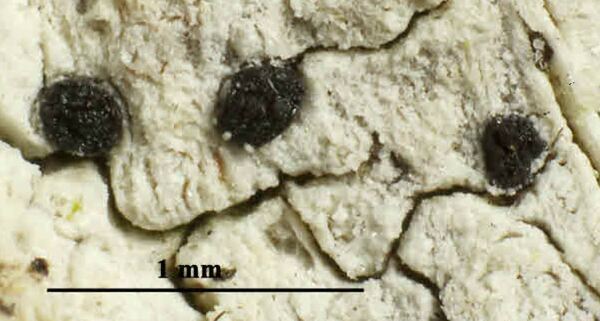

Felix Schumm – CC BY-SA 4.0
[19309], Germany, Baden-Württemberg, Kreis Göppingen, nördlich von Reichenbach bei der Bannmühle, an Quercus in der Franzosenklinge, 48.73647° N, 9.46674° E, 320 m. Leg. et det. F. Schumm, 08.03.2015
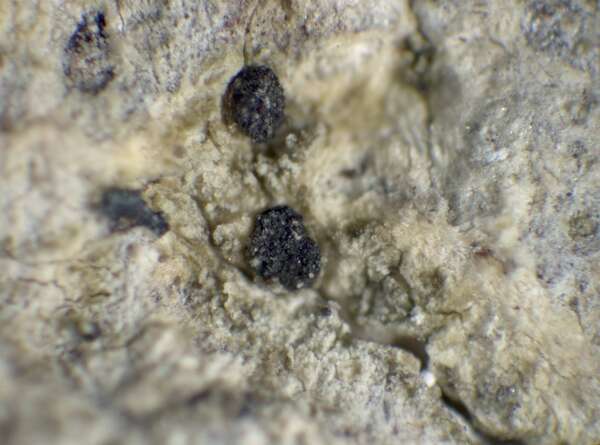

P.L. Nimis; Owner: Department of Life Sciences, University of Trieste
Herbarium: TSB (10604)
2001/11/22


Felix Schumm – CC BY-SA 4.0
[19309], Germany, Baden-Württemberg, Kreis Göppingen, nördlich von Reichenbach bei der Bannmühle, an Quercus in der Franzosenklinge, 48.73647° N, 9.46674° E, 320 m. Leg. et det. F. Schumm, 08.03.2015


Felix Schumm – CC BY-SA 4.0
[19309], Germany, Baden-Württemberg, Kreis Göppingen, nördlich von Reichenbach bei der Bannmühle, an Quercus in der Franzosenklinge, 48.73647° N, 9.46674° E, 320 m. Leg. et det. F. Schumm, 08.03.2015
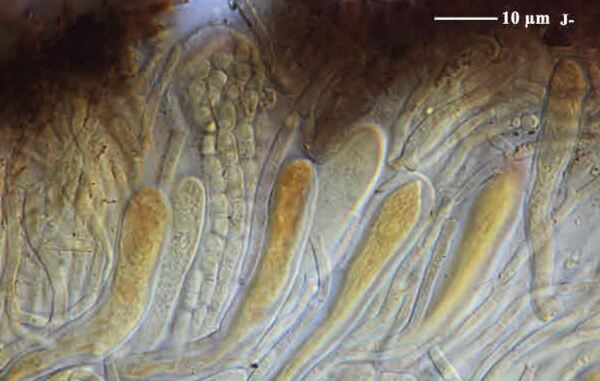

Felix Schumm – CC BY-SA 4.0
[19309], Germany, Baden-Württemberg, Kreis Göppingen, nördlich von Reichenbach bei der Bannmühle, an Quercus in der Franzosenklinge, 48.73647° N, 9.46674° E, 320 m. Leg. et det. F. Schumm, 08.03.2015


Felix Schumm – CC BY-SA 4.0
[19309], Germany, Baden-Württemberg, Kreis Göppingen, nördlich von Reichenbach bei der Bannmühle, an Quercus in der Franzosenklinge, 48.73647° N, 9.46674° E, 320 m. Leg. et det. F. Schumm, 08.03.2015
Growth form: Crustose
Substrata: bark
Photobiont: Trentepohlia
Reproductive strategy: mainly sexual
Most common in areas with a humid-warm climate (e.g. most of Tyrrenian Italy)
In underhangs rarely wetted by rain
Commonnes-rarity: (info)
Alpine belt: absent
Subalpine belt: absent
Oromediterranean belt: absent
Montane belt: absent
Submediterranean belt: extremely rare
Padanian area: absent
Humid submediterranean belt: extremely rare
Humid mediterranean belt: extremely rare
Dry mediterranean belt: absent

Predictive model
| Herbarium samples |


Felix Schumm – CC BY-SA 4.0
[19309], Germany, Baden-Württemberg, Kreis Göppingen, nördlich von Reichenbach bei der Bannmühle, an Quercus in der Franzosenklinge, 48.73647° N, 9.46674° E, 320 m. Leg. et det. F. Schumm, 08.03.2015


P.L. Nimis; Owner: Department of Life Sciences, University of Trieste
Herbarium: TSB (10604)
2001/11/22


Felix Schumm – CC BY-SA 4.0
[19309], Germany, Baden-Württemberg, Kreis Göppingen, nördlich von Reichenbach bei der Bannmühle, an Quercus in der Franzosenklinge, 48.73647° N, 9.46674° E, 320 m. Leg. et det. F. Schumm, 08.03.2015


Felix Schumm – CC BY-SA 4.0
[19309], Germany, Baden-Württemberg, Kreis Göppingen, nördlich von Reichenbach bei der Bannmühle, an Quercus in der Franzosenklinge, 48.73647° N, 9.46674° E, 320 m. Leg. et det. F. Schumm, 08.03.2015


Felix Schumm – CC BY-SA 4.0
[19309], Germany, Baden-Württemberg, Kreis Göppingen, nördlich von Reichenbach bei der Bannmühle, an Quercus in der Franzosenklinge, 48.73647° N, 9.46674° E, 320 m. Leg. et det. F. Schumm, 08.03.2015


 INDEX FUNGORUM
INDEX FUNGORUM
 GBIF
GBIF
 DOLICHENS
DOLICHENS
